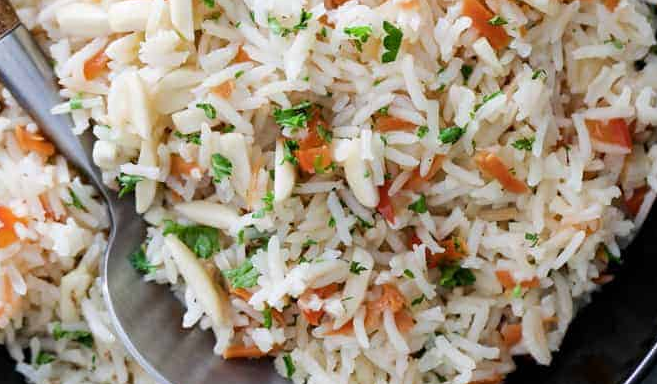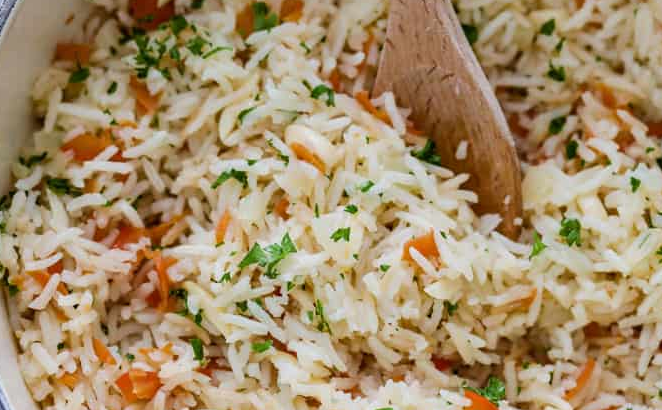
How to Make Rice Pilaf with Leftover Rice A Simple and Flavorful Recipe
Leftover rice is a common kitchen dilemma—it’s often too good to waste, but plain rice can be a bit boring to serve again. Fortunately, turning leftover rice into a delicious and versatile rice pilaf is an excellent way to give it new life. Rice pilaf, with its rich flavors, toasted spices, and fluffy texture, is the perfect way to elevate simple, leftover rice into a dish worthy of a family meal or a fancy dinner party.
In this article, we’ll guide you through the process of making rice pilaf using leftover rice. We’ll cover ingredients, step-by-step instructions, tips for success, and ideas for delicious variations to suit any palate.
What is Rice Pilaf?
Rice pilaf is a flavorful rice dish that’s traditionally made by sautéing raw rice in butter or oil with aromatics like onions and garlic before simmering it in broth. The toasting process gives the rice a nutty depth of flavor, and the broth infuses it with richness. By using leftover rice, we simplify the process while maintaining that classic pilaf flavor.
Using leftover rice instead of starting from scratch reduces cooking time and helps prevent food waste. It’s a win-win for busy home cooks looking for an easy, tasty side dish or main course.
Ingredients for Making Rice Pilaf with Leftover Rice
The basic ingredients needed to transform your leftover rice into a flavorful pilaf are likely already in your kitchen. Here’s what you’ll need:
- 3 cups leftover cooked rice (preferably long-grain varieties like basmati or jasmine)
- 2 tablespoons olive oil or butter
- 1 small onion, finely diced
- 2 garlic cloves, minced
- 1/2 teaspoon salt (adjust to taste)
- 1/4 teaspoon ground black pepper
- 1/2 teaspoon ground cumin or turmeric (optional for extra flavor)
- 1/2 cup chicken broth or vegetable broth
- 1/4 cup peas or diced carrots (optional, for added color and texture)
- 1/4 cup toasted nuts (like slivered almonds or pine nuts, optional)
- Fresh parsley or cilantro for garnish
These ingredients make for a simple yet delicious pilaf. You can easily customize it with different vegetables, proteins, or spices to suit your tastes.
Step-by-Step Instructions for Making Rice Pilaf with Leftover Rice
Follow these simple steps to turn your leftover rice into a flavorful rice pilaf.
1. Prepare the Leftover Rice
Take your cold, leftover rice out of the fridge and let it sit at room temperature for about 10-15 minutes. Cold rice can sometimes clump together, so breaking it up with your hands or a fork will help ensure even cooking later on.
Tip: Leftover rice that’s a day or two old works best for rice pilaf because it holds its shape and texture better than freshly cooked rice.
2. Sauté the Aromatics
A big skillet or sauté pan should be heated to medium heat. Add the olive oil or butter and allow it to melt and heat through.
- Add the diced onion to the skillet and sauté for 3-4 minutes, stirring frequently, until softened and translucent.
- Next, add the minced garlic and continue to sauté for another 30 seconds to 1 minute, until fragrant.
Sautéing the onions and garlic creates a flavorful base for the pilaf, adding depth and richness to the dish.
3. Add the Spices and Broth
Once the onions and garlic are fragrant, stir in the ground cumin or turmeric (if using). These spices add warmth and a subtle flavor to the rice. If you prefer a more neutral flavor, you can skip this step or replace these spices with others like paprika or ground coriander.
- Pour in the chicken or vegetable broth. The broth not only adds moisture to the dish but also enhances the flavor of the rice. Bring the mixture to a simmer after stirring everything together.
4. Add the Leftover Rice
Once the broth is simmering, gently fold in the leftover rice. Break up any remaining clumps of rice, ensuring that the grains are evenly coated with the broth and aromatics.
- Continue to cook the rice over medium heat, stirring occasionally, for about 5-7 minutes, or until the rice is heated through and has absorbed most of the broth.
Tip: Be gentle when stirring the rice to avoid breaking up the grains, which can make the pilaf mushy. A gentle folding motion works best.
5. Add Optional Vegetables and Garnishes
For extra color and texture, stir in any vegetables you’d like to add, such as peas or diced carrots. If you’re using frozen peas, you can add them straight from the freezer—they’ll warm up quickly in the hot rice. Cook for an additional 2-3 minutes, until the vegetables are heated through.
Once the rice is fully warmed and the vegetables are tender, remove the skillet from the heat. Stir in any toasted nuts or fresh herbs you’re using, such as chopped parsley or cilantro, for a fresh and crunchy finish.
6. Serve and Enjoy
Your rice pilaf is now ready to serve! Transfer the pilaf to a serving dish, garnish with more fresh herbs or a sprinkle of toasted nuts, and enjoy it as a flavorful side dish or main course.

Tips for Success When Making Rice Pilaf with Leftover Rice
1. Use Cold Rice: Cold, leftover rice is ideal for making pilaf because the grains are firm and separate, which helps prevent the dish from becoming mushy.
2. Break Up Clumps: If your rice is clumped together after being refrigerated, break it up with a fork or your hands before adding it to the skillet. This ensures even heating and better texture.
3. Sauté the Aromatics: Don’t skip the step of sautéing onions and garlic in oil or butter. This is essential for building flavor in the dish, and it gives the pilaf a rich, savory base.
4. Use Broth for Extra Flavor: Adding broth instead of plain water adds depth of flavor to the rice. If you don’t have broth, you can use water with a pinch of salt and a little butter or oil for added richness.
5. Customize with Add-Ins: Rice pilaf is incredibly versatile. You can mix in vegetables like peas, carrots, or bell peppers, or add proteins like chicken, shrimp, or even tofu. Toasted nuts and dried fruits, like almonds or raisins, can also give the dish a delightful texture and flavor contrast.
Variations on Rice Pilaf with Leftover Rice
1. Vegetable Rice Pilaf
For a vegetarian version, add more vegetables to the pilaf. Diced carrots, bell peppers, and peas make excellent additions. You can also stir in leafy greens like spinach or kale toward the end of cooking for added nutrients.
2. Chicken Rice Pilaf
If you have leftover cooked chicken, shred or dice it and stir it into the rice during the last few minutes of cooking. The chicken will warm through and add heartiness to the pilaf, making it a more filling meal.
3. Seafood Rice Pilaf
For a seafood variation, stir in cooked shrimp or scallops just before serving. The seafood adds a touch of elegance and pairs well with the lightly spiced rice.
4. Middle Eastern-Inspired Pilaf
For a Middle Eastern twist, add a blend of spices like cumin, coriander, and cinnamon to the pilaf. You can also stir in toasted pine nuts and dried currants or raisins for a sweet-savory flavor combination.
5. Herb Pilaf
For a fresh and herbaceous version, stir in a variety of chopped herbs such as dill, cilantro, parsley, and mint. The herbs will brighten up the dish and make it perfect for pairing with grilled meats or vegetables.
Serving Suggestions for Rice Pilaf with Leftover Rice
Rice pilaf is incredibly versatile and pairs well with many different dishes. Here are a few ideas for serving your pilaf:
As a Side Dish: Serve the pilaf alongside roasted or grilled chicken, beef, lamb, or fish. It pairs especially well with Mediterranean and Middle Eastern dishes.
As a Main Course: Add protein like chicken, shrimp, or tofu to the pilaf for a hearty, filling main course. You can also add extra vegetables for a nutrient-packed meal.
With a Salad: Pair the pilaf with a fresh cucumber-tomato salad or a leafy green salad for a light and refreshing meal.
With Yogurt: Serve the pilaf with a dollop of Greek yogurt or tzatziki on the side for a creamy, tangy contrast.
Conclusion
Transforming leftover rice into a flavorful rice pilaf is a great way to reduce food waste while creating a delicious dish. With just a few basic ingredients and some simple techniques, you can have a flavorful, aromatic rice pilaf on the table in no time. Whether you’re serving it as a side dish or a main course, rice pilaf with leftover rice is sure to be a hit with your family or guests.
Get creative with spices, vegetables, and proteins to make this dish your own. Once you master the basics, rice pilaf can become a versatile go-to recipe in your kitchen!
